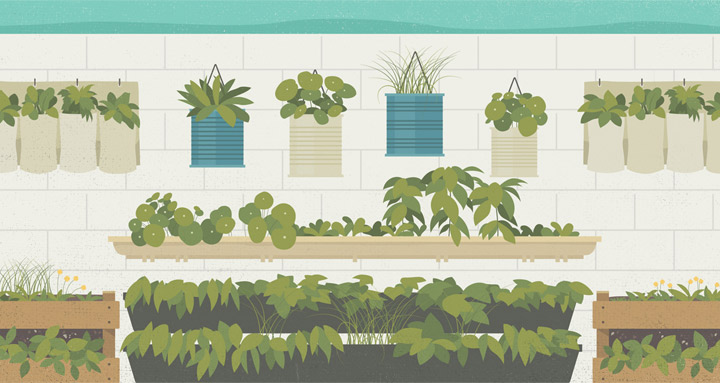Want to multiply the number of plants you can grow in a garden or on a patio or deck? Grow up! Vertical gardening, a technique to cultivate plants up surfaces or supports, is the perfect way to squeeze lots of plants into a small space. Growing up, rather than out, offers countless other benefits beyond higher plant yields.
Vertical Veggies
Vegetable gardeners have plenty to gain by adding vertical supports to the garden, including:
- Higher plant yields
- More plant diversity in less space
- Less weeding
- Less bending and squatting
- Easier tending and harvesting
- Plants have better air circulation and access to sunlight, which means fewer diseases and pests
- Better access for pollinators
- Less need for expensive soil and amendments
- Visual intrigue and the ability to hide unsightly views
Some edibles work better in a vertical garden than others. Look for vining plants instead of bush types. The following are excellent choices:
- Pole beans
- Peas
- Hops
- Cucumbers
- Vining summer squash or gourds
- Grapes
- Nasturtiums
- Tomatoes: Choose vining varieties, such as Early Girl or Brandywine for trellises. Bush varieties, such as Roma, work best in cages.
- Small melons
With a plan, careful pruning, and some patience, fruit trees can be trained to grow up a flat surface or support, a process called espaliering. Common choices include pear, apple, peach, fig, and pomegranate trees. A horizontal espalier pattern works well for fruit trees. Mature forms can produce 30 to 60 pounds of fruit per season.
The ABCs of Garden Supports
Garden supports can be purchased at any garden supply shop. DIY enthusiasts can fashion them out of reclaimed materials such as bamboo, baling twine, untreated wood, netting, fencing, gates, chicken wire, a discarded bed frame, or a ladder.

Nature offers additional support systems for vining plants. For instance, Native Americans used corn stalks as a sturdy, living support system for beans. To imitate their famous Three Sisters Garden:
- Pile soil into four-foot wide mounds (do this after the last frost).
- Sow six kernels of corn one inch deep and about 10 inches apart in a circle.
- When the corn is five inches tall, plant four bean seeds, evenly spaced, around each stalk. The bean vines naturally coil around the corn without harming the corn plants.
- A week later, plant six squash seeds, evenly spaced, around the mound. The squash plants not only produce nutritious food; they also suppress weed growth. Another method is to alternate mounds of squash with mounds of beans and corn.
Similarly, sunflowers can serve as sturdy supports for cucumbers. To grow these companion plants together, plant cucumbers around sunflowers when the flowers are about 12 inches tall.
Containing the Vertical Garden
A garden plot isn’t necessary to tap into the space-saving benefits of vertical gardening. With a little creativity, nearly any container with drainage holes can be adapted into a vertical garden. These five container gardens are sure to add intrigue to a balcony, patio, wall, or fence and produce vegetables, herbs, or flowers despite tight quarters.
Pallet Herb Garden
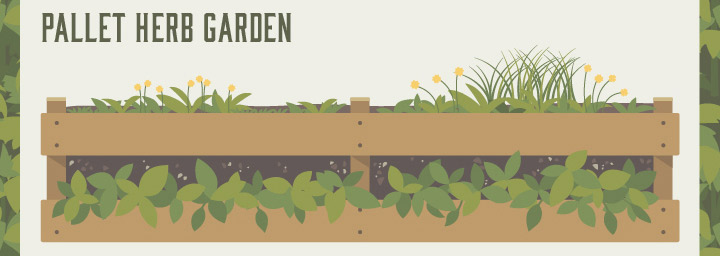
Supplies:
- Reclaimed wood pallet in good condition
- Small roll of landscape fabric
- Hammer
- Nails
- Staple gun
- Staples
- Sandpaper
- Two large bags of potting soil
- Herb plants or seeds
How to construct a pallet garden:
- Find a pallet. Ask at grocery stores, home improvement stores, and local recycling centers. Make sure the pallet is marked HT, indicating it was heat-treated without chemicals. (If a heat-treated pallet isn’t available, it’s best to grow ornamentals, such as flowers or succulents, instead of edibles.)
- Sand the pallet and pull any loose nails. Wash with soapy water and let dry.
- Lay the pallet face down and cover the back and bottom with two layers of landscape fabric. Pull the fabric taut and secure with a staple every two inches on the wooden surface.
- Turn the pallet over and fill it with potting soil. It will be heavy, so it’s best to fill it near its permanent location.
- Plant a variety of herb starts or seeds. Pack the soil tightly around them.
- Leave the pallet flat for several weeks to let plants settle. Water daily.
- Get help to lift the pallet, and lean it against the side of a building or fence.
- Water daily in hot weather and fertilize regularly.
- Enjoy fresh herbs!
Rain Gutter Garden

Supplies:
- Metal gutters
- Gutter caps
- Gutter hangers
- Metal cutters
- Drill
- Potting soil
- Starts or seeds
How to construct a gutter garden:
- Buy new gutters or reclaim old ones. (Look on Craigslist, Freecycle, or a local recycling yard.) The quantity and dimensions will vary to suit the fence or building on which they will be mounted.
- Wash gutters with soapy water.
- Decide how you will arrange the gutters. Try three or four rows and experiment with designs.
- Use metal cutters to cut the gutters if necessary and glue on endcaps.
- Drill drainage holes every three inches on the bottom of the gutters.
- Attach gutters to the fence or wall with gutter hangers.
- Fill gutters with potting soil.
- Plant starts or seeds. Lettuce, salad mix, greens, or strawberries are good choices.
- Water daily in hot weather and fertilize regularly.
Shoe Rack Garden
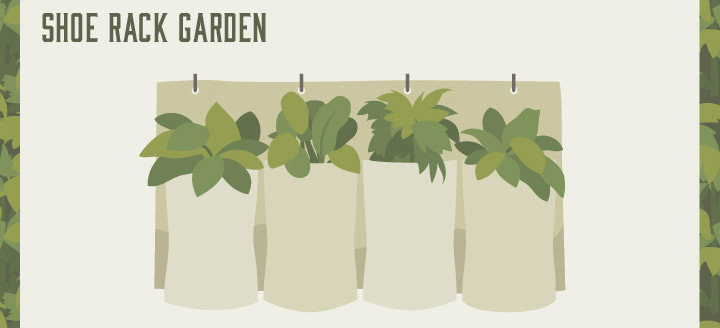
Supplies:
- Canvas or fabric shoe rack
- Hangers
- Screws
- Screwdriver
- Potting soil
- Seeds or starts
How to construct a shoe rack garden:
- Buy or reclaim a canvas or fabric shoe rack.
- Hang it on a wall or fence.
- Plant herbs, strawberries, greens, or ornamentals. Pack potting soil tightly in the pockets.
* You could also try a wooden wine rack or spice rack in the same way.
Tin Can Garden
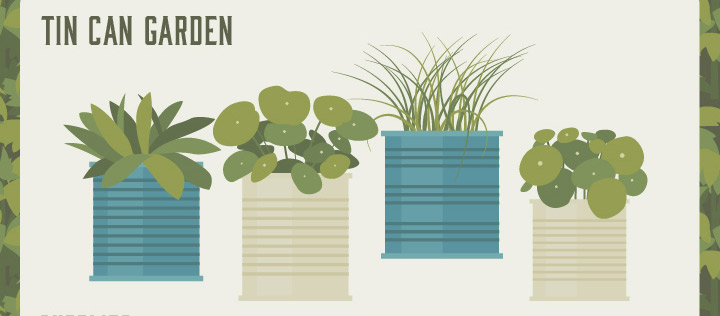
Supplies:
- 10 to 12 recycled tin cans
- Marker
- Tape measure
- Screws
- Electric screwdriver
- Potting soil
- Seeds or starts
How to construct a tin can garden:
- Decide where to put the garden and how to arrange the cans. Use the tape measure and marker to mark where each can will go.
- Wash the cans and remove any labels.
- Punch three drainage holes in the bottom of each can with a nail and hammer.
- Hang the cans on the fence or wall with screws.
- Add potting soil and plant seeds or starts. Herbs or flowers are good options.
- Water daily in hot weather and fertilize regularly.
- The cans will rust eventually, so plan to replace the garden each season.
* You can also try rain boots, recycled plastic bottles, terra cotta pots (hung with special hangers), and wooden planters in the same way.
Living Wall
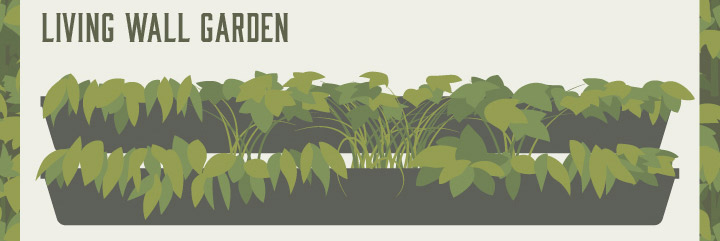
Even with no growing space, gardeners can take advantage of vertical gardening by transforming a wall into a living wall. Living walls absorb heat, reduce noise, improve air quality, and can rival beautiful works of art. When installed outdoors, they also create habitat for birds, insects, and butterflies.
Supplies:
- Vertical garden panels
- Seeds or starts
- Potting soil
- Tools for installation (varies by type of panel)
How to construct a living wall garden:
- Choose and purchase the type of panel desired. Several manufacturers make trays of slanted slots that can fit together to make large installations. Some have moisture mats or irrigation systems that help distribute water evenly, some come with mounting brackets, and some are meant for outdoor installation only. They range considerably in price and size so research carefully to find the right panels for the project. They make building, installing, and caring for a living wall a cinch.
- Plant starts in each slot and pack potting soil tightly around them. Edibles with small roots, such as greens, lettuce, and strawberries, grow well on living walls. Just be sure to look for panels made of food-safe materials.
- Lay the panel flat for several weeks to help the plants get established.
- Hang the panel on a wall that is in the sunlight for most of the day. Make sure the planter is mounted on brackets to sit away from the wall or that the wall is protected from moisture.
- Water daily in hot weather and fertilize regularly.
Conclusion
With some creativity, gardeners can devise any number of other unusual, beautiful vertical gardens. No matter which garden you construct, you’re sure to benefit from growing upward (Via CustomMade).
If you like this idea, be sure to share it with your friends and inspire someone you know. Anything becomes possible with just a little inspiration…
